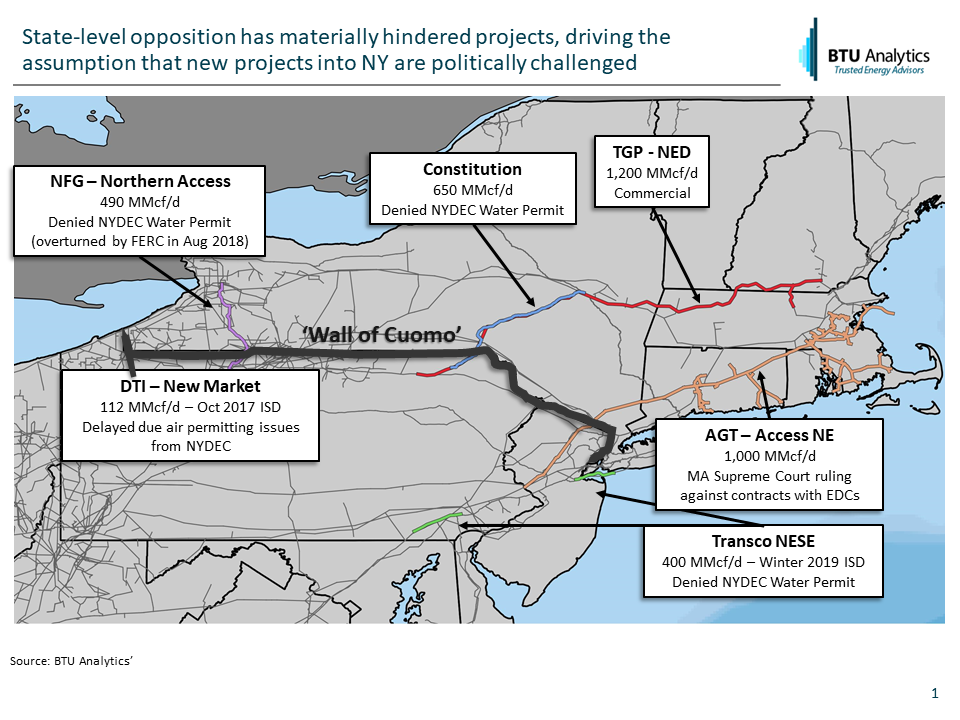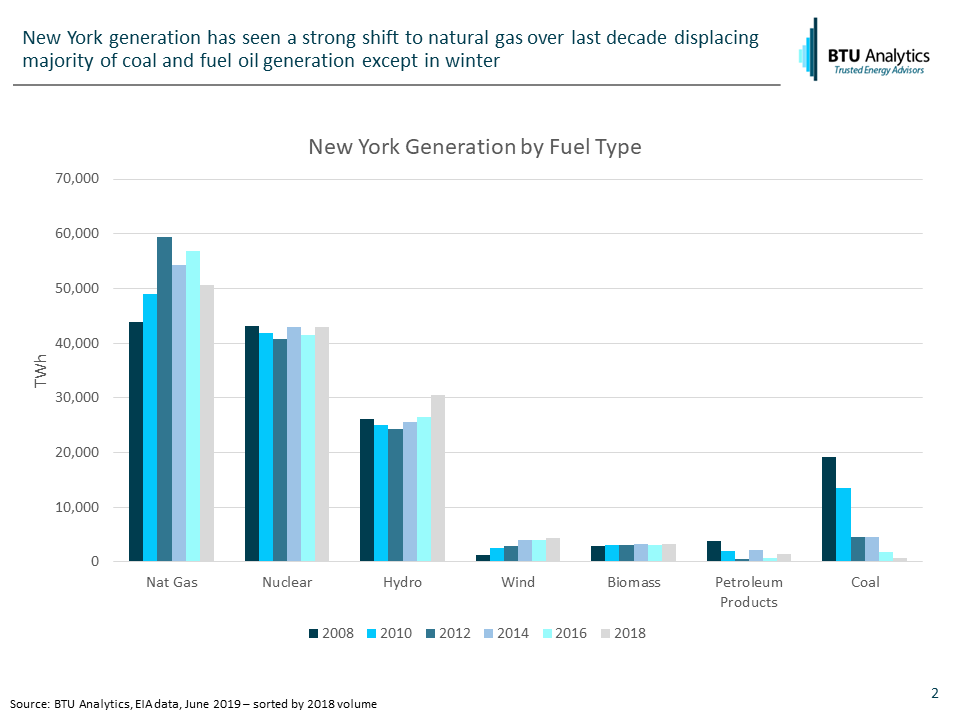The environmental blockade of new pipelines into New York and New England may finally be coming to an end. In a rare move, the Environmental Defense Fund (EDF) has come out in support of a gas pipeline project into the New York market in order to reduce the higher emission levels from fuel oil generation on peak winter days. This Energy Market Commentary will look at the role fuel oil plays in the pipeline constrained power markets of New York and New England on peak winter days and why some environmentalists support a gas pipeline into the region.
Environmentalist groups have increasingly used state-level regulatory pipeline delay tactics as a method to keep fossil fuels in the ground and prevent emissions. BTU Analytics coined the ‘Wall of Cuomo’ to describe the nearly impenetrable boundary for new gas pipeline development into New York. The regulatory delays have resulted in limited new gas supply from Northeast Pennsylvania (NE PA) being able to reach the premium demand markets in New York and New England. As shown below, the inability to get new pipeline capacity into these demand markets is the main reason for winter demand price spikes in Boston and New York City. On peak winter days, high natural gas prices push power generation into fuel switching mode as fuel oil burn ramps significantly higher to meet demand.

EDF recently filed comments with the State of New York Public Service Commission acknowledging that increased fuel oil use during peak winter days in New York and New England leads to unnecessarily higher emissions levels. EDF specifically identifies Williams’ Transco Northeast Supply Enhancement Project (NESE) as an appropriate solution to benefit the climate by increasing gas supply into the New York market area thereby decreasing fuel oil emissions. NESE would increase capacity on Transco by 400 MMcf/d from key interconnects in New Jersey into the New York City market area on Long Island. For those following gas pipeline development in the Northeast, having an environmental group provide supportive comments about a gas pipeline is a 180 degree shift in sentiment.
Shown below is annual New York state generation which shows that natural gas, nuclear and hydro provide the most generation. Natural gas capacity and generation have increased in recent years while fuel oil and coal have been in decline. When cold weather hits the region, natural gas prices spike incentivizing power generators to switch from gas to fuel oil. As a result, fuel oil still plays a key role in winter power generation. As shown below, fuel oil does not generate a large volume of electricity annually but when and at what price remains paramount to markets in the Northeast.

Similar to New York, New England’s power generation shows an increased reliance on natural gas, but in New England, fuel oil remains the second largest piece of generation capacity by fuel type. Fuel oil generation capacity remains in New England in part due to the Wall of Cuomo’ preventing new pipelines into the region.

While annually fuel oil is a small component of generation, on a monthly and even daily basis the mix swings significantly. In both the New York and New England generation markets, fuel oil as a percentage of total generation reaches over 10% of monthly generation according to the EIA as shown below. Daily data indicates the situation is even more severe. Below is a screenshot from the New England ISO from January 5, 2018. On this day, severe cold in the region drove demand higher, and as a result, gas and power prices spiked. In response, generators dispatched fuel oil to meet demand. Fuel oil generation represented 38% of total generation during that day while gas represented just 15% and coal represented another 6% of generation. EDF has cause to be concerned about days like this as it relates to power generation emissions.

Ironically, when looking at daily gas pipeline nomination data in New England for January 2018, power burn averaged 717 MMcf/d with the four-day cold snap removed. On January 5, power burn was 320 MMcf/d, a 396 MMcf/d drop from the average for the month. Ironic considering NESE is 400 MMcf/d and would deliver supply to the New York City market. Perhaps EDF should support more pipelines into New England. To follow gas pipeline infrastructure development across the U.S., request more information about BTU Analytics’ Gas Basis Outlook.








